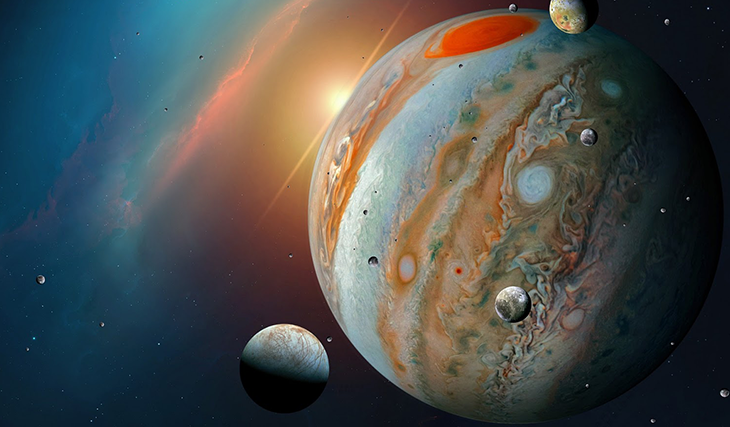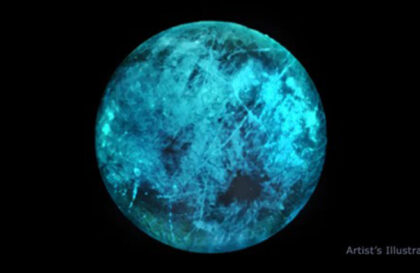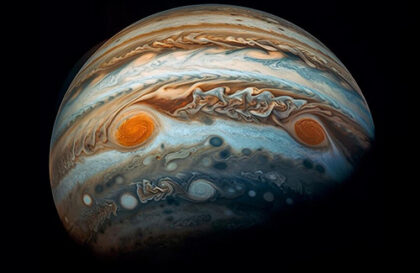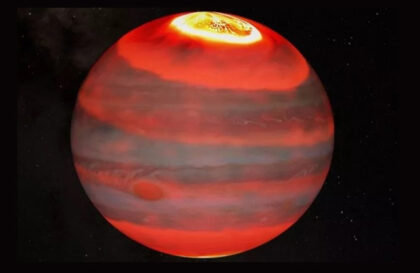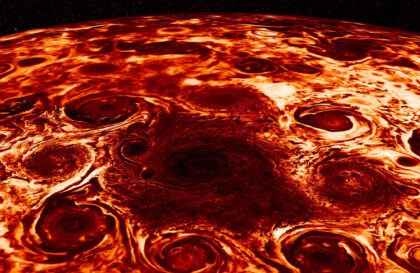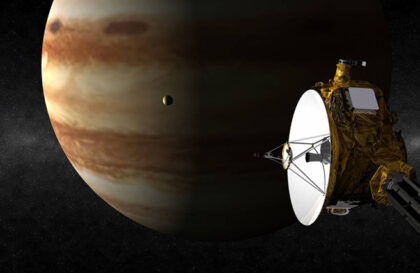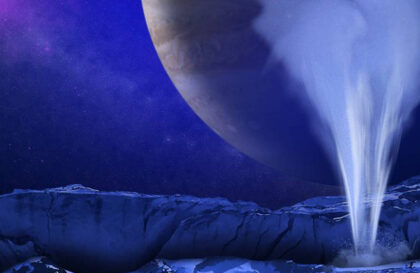“Sweeper” of the Solar System
Jupiter is the most massive planet in the solar system and therefore has a vast sphere of gravitational influence. This is an area of space where, under favorable conditions, an asteroid can be captured. Interestingly, its gravitational field is elongated along the north-south axis, while the Earth’s gravitational field is flattened at the poles. This doesn’t change anything for asteroids.
A 2018 study estimated that Jupiter had between 10 and 65 impacts of meteoroids ranging from 5 to 20 meters (16 to 66 ft) in diameter per year. An asteroid of this size does not leave visible marks on the giant.
Larger objects leave a visible scar on the planet’s cloud cover for weeks. This study gives a frequency of such collisions of once every 2–12 years. Even larger objects will collide with Jupiter every 6 to 30 years. Research from 2009 suggests that the impact rate of an object with a diameter of 0.5 to 1 km (0.31 to 0.62 mi) is once every 50 to 350 years and that of comets with a diameter of 1.6 km (0.99 mi) – once every 6000 years.
These studies live up to Jupiter’s reputation as the “vacuum cleaner of the solar system.”
Impact events
First recorded event
The meteoroid impact with Jupiter was first detected on March 5, 1979, at 17:45:24 UTC by the Voyager 1 spacecraft, which detected a rapid flicker of light in the planet’s atmosphere. The meteoroid’s mass was about 11 kg.
Comet Shoemaker-Levy 9
On July 16, 1994, Comet Shoemaker-Levy 9 collided with Jupiter’s atmosphere. The collision was expected and observed from Earth using telescopes and space observatories, including the Hubble Space Telescope, ROSAT, Keck Observatory, and the Galileo spacecraft.
Galileo was located 1.6 astronomical units (240 million kilometers; 150 million miles) from Jupiter and was able to observe impacts as they occurred (after crossing the Roche limit, the comet was torn to pieces by the planet’s gravitational field, so there were many impact events).
Two other spacecraft, Ulysses and Voyager 2, also observed the impacts. Ulysses was 2.6 astronomical units (390 million kilometers; 240 million mi) from Jupiter, and Voyager 2 was 44 astronomical units (6.6 billion kilometers; 4.1 billion mi) from the planet.
These missions observed various aspects of the impacts, including radio emissions and the ultraviolet spectrum.
The first fragment of the comet crashed into Jupiter’s southern hemisphere at a speed of about 60 km/s (35 mph). Instruments on Galileo detected a fireball that reached a peak temperature of about 24,000 K (23,700 °C; 42,700 °F) compared to Jupiter’s typical cloud top temperature of about 130 K (−143 °C; −226 °F ). It then expanded and cooled rapidly to about 1,500 K (1,230 °C; 2,240 °F). The fireball’s plume quickly reached an altitude of over 3,000 km (1,900 mi) and was recorded by Hubble Space Telescope.
Over the next six days, 21 distinct impacts were observed, the largest of which created a large dark spot over 12,000 km or 7,500 miles in area – almost the same diameter as the Earth.
I note that this is the only collision where a body was observed entering the atmosphere of Jupiter. In all other cases, consequences were observed.
Collisions 2009 – 2012
On July 19, 2009, amateur astronomer Anthony Wesley discovered a new Earth-sized black spot in Jupiter’s southern hemisphere. The impact was caused by an ice object ranging in size from 500 to 1000 meters or a rocky object measuring from 200 to 500 meters. This object created a debris field that was visible from Earth for several months.
In 2010, there was another collision with an object ranging from 8 to 13 meters, captured on video in the Philippines.
There was another impact in 2012, which was captured by amateur astronomers and counted as a meteoroid impact less than 10 meters in diameter.
According to scientists’ calculations based on data on the populations of asteroids and comets near the orbit of Jupiter, from 30 to 100 collisions occur there per year. For the Earth, the estimated frequency of collisions with an object of this size is once every 6–15 years.
Following the April 10, 2020 impact observed by the Juno probe, the estimates were revised. The number of impacts on Jupiter caused by meteoroids weighing between 250 and 5,000 kg (550 and 11,020 lb) is approximately 24,000 events per year or about 2.7 per hour.
The rate of comet collisions with Jupiter is thought to be 2,000 to 8,000 times higher than on Earth.
Consequences of collisions
Impacts on a gas giant like Jupiter can have different effects depending on the size and composition of the impacting object.
For small meteoroids, there is a glow as they penetrate Jupiter’s upper atmosphere, but in some cases, as in 2010, no change in the clouds is observed.
When hitting objects with a diameter of more than 100 meters, the phenomenon becomes more complex. Most of the kinetic energy is transferred to the atmosphere, causing a rapid increase in temperature and intense light emission. This can lead to the formation of a plume up to 1000 kilometers long and temperatures up to 1000 Kelvin within a few seconds. When expansion stops, the plume settles, causing a new rise in temperature and lifting material from deep in the atmosphere.
Collisions can cause:
- Seismic waves travel across the planet, reaching speeds of 450 meters per second, and are observed for more than two hours after the collision.
- In some cases, auroras may appear near the impact site and in the antipodal zone, associated with the fallout of plume material and interpreted relative to Jupiter’s magnetic field.
- Impacts produce a dark spot in the visible and ultraviolet ranges, but it is bright in the infrared range. The size of this spot depends on the intensity of the infrared radiation from the impact plume.
- Small spots may disappear after a few days or weeks, but larger ones persist for several months, becoming deformed over time. Repeated collisions can produce a “strike of impact,” corresponding to the stripe occupied by the spots.
Credit рhoto:
https://exoplanetscience.org
https://www.missionjuno.swri.edu
https://www.missionjuno.swri.edu
https://www.missionjuno.swri.edu
